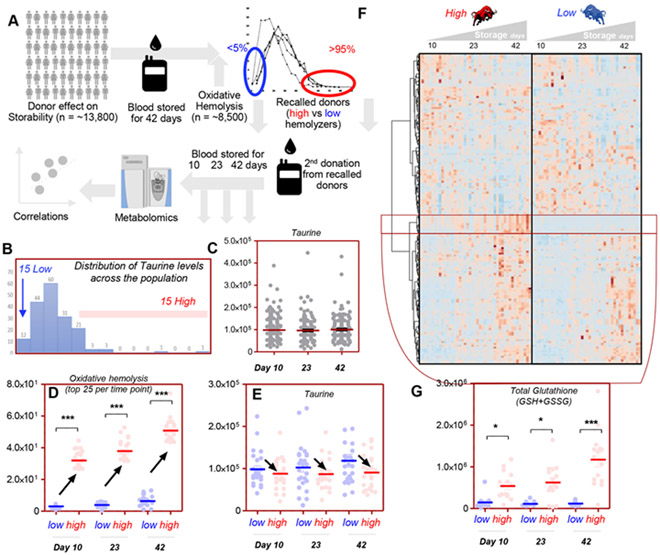Fig. 5.
Taurine negatively correlates with the RBC propensity to hemolyze after oxidant stress in the REDS-III RBC-Omics recalled donor population. Within the framework of the REDS-III RBC-Omics study, a large cohort (13,400) of healthy volunteers donated a unit of blood (A). Units were stored until the end of their shelf life (42 days) and then tested for the propensity to hemolyze after oxidant insult with AAPH. Donors with the lowest (5th) and highest (95th) oxidative hemolysis variables were asked to donate a second unit of blood, which was stored for up to 42 days and sampled sterilely on Days 10, 23, and 42 for taurine measurements based on chromatographic retention times and high-resolution intact mass spectra via UHPLC-MS. Taurine levels are not normally distributed across the population (B) and are not impacted by storage duration (C). Sorting of the extreme 25 high (red) and low (blue) oxidative hemolysis donors in the recalled donor population (D) highlighted a negative correlation between taurine levels and oxidative hemolysis (E). In F, a hierarchical clustering analysis was performed on the metabolites significant by ANOVA (time series, one-variable) from the metabolomics data of stored RBCs (Days 10, 23, and 42) from REDS-III RBC-Omics donors with the 15 highest and lowest levels of taurine. A vectorial version of this heat map, including metabolite names is provided in Fig. S3. In particular, taurine levels were positively associated with increases in several glutathionylated metabolites, with total GSH (reduced glutathione + GSSG) levels being significantly higher in the high-taurine group at each one of the tested time points (G).

